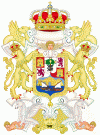Castro Urdiales (Castro-Urdiales)
 |
 |
Although the number of people registered in the town is around 32,000, the summer population can double or even triple this figure. The town is popular because of its beaches and scenic harbor.
Castro Urdiales was originally called Portus Amanum, and was the chief city of the Autrigones. In AD 74 a Roman colony was established under the name Flaviobriga, during the reign of emperor Vespasian. It was most likely established to mine the abundant iron in the area.
In 1163 the town of Castro Urdiales received its municipal charter. It lay at the western tip of the coastline of Navarre until 1200, when the kingdom was invaded by Alfonso VIII of Castile. Castro Urdiales benefited much from its location at a crossroads in the trade between northern Europe and Castile. It remained in Biscay until 1476 at least, but it is not cited in the seigneury's assemblies thereafter. Until the 18th century, the town recurrently attempted a reincorporation to Biscay (attested in 1799), but its attempts were met with the frontal refusal of Bilbao on account that it could tip the scale against its own trade balance.
It was destroyed by the French in 1813, but was speedily rebuilt and fortified. Its rapid rise in population and prosperity dates from the increased development of iron mining and railway communication which took place after 1879.
Map - Castro Urdiales (Castro-Urdiales)
Map
Country - Spain
 |
 |
| Flag of Spain | |
Anatomically modern humans first arrived in the Iberian Peninsula around 42,000 years ago. The ancient Iberian and Celtic tribes, along with other pre-Roman peoples, dwelled the territory maintaining contacts with foreign Mediterranean cultures. The Roman conquest and colonization of the peninsula (Hispania) ensued, bringing the Romanization of the population. Receding of Western Roman imperial authority ushered in the migration of different non-Roman peoples from Central and Northern Europe with the Visigoths as the dominant power in the peninsula by the fifth century. In the early eighth century, most of the peninsula was conquered by the Umayyad Caliphate, and during early Islamic rule, Al-Andalus became a dominant peninsular power centered in Córdoba. Several Christian kingdoms emerged in Northern Iberia, chief among them León, Castile, Aragon, Portugal, and Navarre made an intermittent southward military expansion, known as Reconquista, repelling the Islamic rule in Iberia, which culminated with the Christian seizure of the Emirate of Granada in 1492. Jews and Muslims were forced to choose between conversion to Catholicism or expulsion, and eventually the converts were expelled through different royal decrees.
Currency / Language
| ISO | Currency | Symbol | Significant figures |
|---|---|---|---|
| EUR | Euro | € | 2 |
| ISO | Language |
|---|---|
| EU | Basque language |
| CA | Catalan language |
| GL | Galician language |
| OC | Occitan language |
| ES | Spanish language |
















